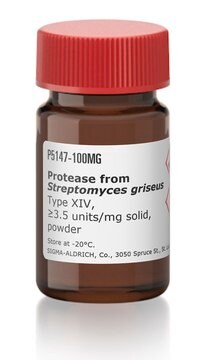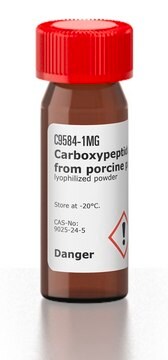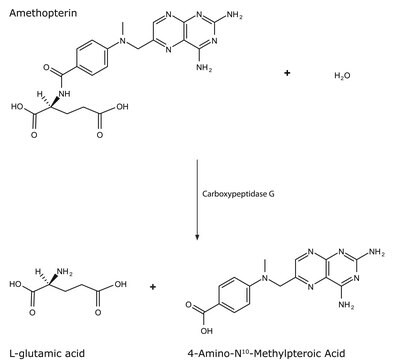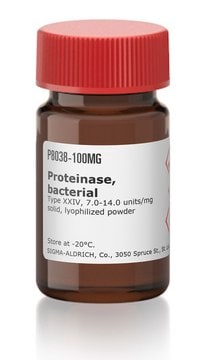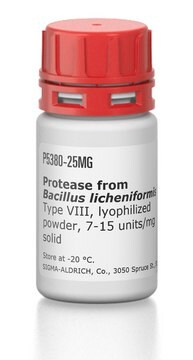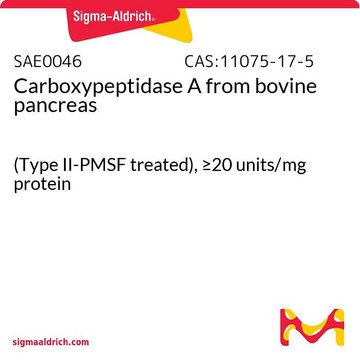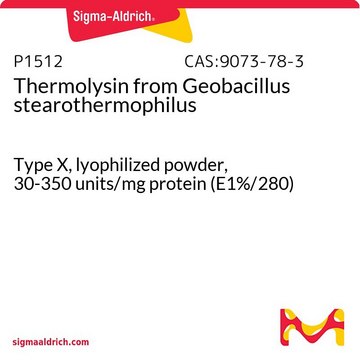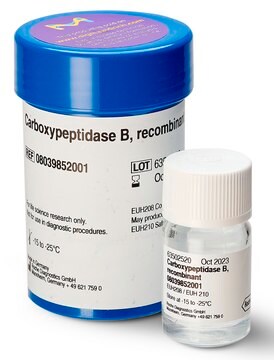Alle Fotos(1)
Wichtige Dokumente
C3888
Carboxypeptidase Y aus Backhefe (S. cerevisiae)
lyophilized powder, ≥50 units/mg protein
Synonym(e):
Peptidyl-L-aminosäure-Hydrolase, Serin-Carboxypeptidase
Anmeldenzur Ansicht organisationsspezifischer und vertraglich vereinbarter Preise
Alle Fotos(1)
About This Item
CAS-Nummer:
MDL-Nummer:
UNSPSC-Code:
12352204
NACRES:
NA.54
Empfohlene Produkte
Qualität
Proteomics Grade
Qualitätsniveau
Form
lyophilized powder
Spezifische Aktivität
≥50 units/mg protein
Mol-Gew.
61 kDa
Zusammensetzung
Protein, ≥75% E1%/280
Versandbedingung
wet ice
Lagertemp.
−20°C
Suchen Sie nach ähnlichen Produkten? Aufrufen Leitfaden zum Produktvergleich
Verwandte Kategorien
Anwendung
Carboxypeptidase Y has a broad specificity and is stable in urea. Hence, this enzyme is not like other carboxypeptidases and can be used for sequence analysis. Due to its amidase action, this enzyme might be applied to the sequence analysis of peptides having amidated COOH-terminal groups such as oxytocin and vasopressin.
Biochem./physiol. Wirkung
The glycoprotein has a molecular weight of about 61,000, has a nitrogen content of 12.74%. It is a single polypeptide chain of 442 residues with 16 residues of glucosamine in the carbohydrate moiety. Lysine is at the NH2 terminus and -Asp-Ser-Thr-Leu is the COOH-terminal sequence. The principal action of the enzyme is to remove COOH-terminal residues from polypeptide chains. It is used as a vacuolar marker enzyme for studies on protein transport and localization.
Verpackung
Packungsgrösse bezogen auf den Proteingehalt.
Einheitendefinition
1 U hydrolysiert 1.0 μmol N-CBZ-Phe-Ala zu N-CBZ-L-Phenylalanin und L-Alanin pro Minute bei pH 6.75 und 25°C, basierend auf EM/230 = 191.5.
Physikalische Form
Enthält Citrat-Puffer, pH ~5
Hinweis zur Analyse
amidase and esterase activities may be present
Signalwort
Danger
H-Sätze
Gefahreneinstufungen
Eye Irrit. 2 - Resp. Sens. 1 - Skin Irrit. 2 - STOT SE 3
Zielorgane
Respiratory system
Lagerklassenschlüssel
11 - Combustible Solids
WGK
WGK 1
Flammpunkt (°F)
Not applicable
Flammpunkt (°C)
Not applicable
Hier finden Sie alle aktuellen Versionen:
Besitzen Sie dieses Produkt bereits?
In der Dokumentenbibliothek finden Sie die Dokumentation zu den Produkten, die Sie kürzlich erworben haben.
Kunden haben sich ebenfalls angesehen
Caroline A Magalhães et al.
Memorias do Instituto Oswaldo Cruz, 106(2), 146-152 (2011-05-04)
Typical and atypical enteropathogenic Escherichia coli (EPEC) are considered important bacterial causes of diarrhoea. Considering the repertoire of virulence genes, atypical EPEC (aEPEC) is a heterogeneous group, harbouring genes that are found in other diarrheagenic E. coli pathotypes, such as
H R Stennicke et al.
Biochemistry, 35(22), 7131-7141 (1996-06-04)
The activity of serine carboxypeptidases is dependent on a catalytic triad, an oxyanion hole, and a binding site equivalent to those found in the serine endopeptidases. The action of carboxypeptidase Y on substrates containing amino acids, alcohols, and amines as
L Ballou et al.
Proceedings of the National Academy of Sciences of the United States of America, 87(9), 3368-3372 (1990-05-01)
The N-linked oligosaccharides from baker's yeast carboxypeptidase Y were analyzed by 1H NMR and specific mannosidase digestion and found to be identical to those from the Saccharomyces cerevisiae mnn9 mutant bulk mannoprotein. The results support the view that the mnn
Johanna Rankenberg et al.
Experimental eye research, 210, 108704-108704 (2021-07-25)
Advanced glycation end products (AGEs) accumulate with age in human lens capsules. AGEs in lens capsules potentiate the transforming growth factor beta-2-mediated mesenchymal transition of lens epithelial cells, which suggests that they play a role in posterior capsule opacification after
Václava Bauerová et al.
Canadian journal of microbiology, 58(5), 678-681 (2012-04-17)
Vacuoles play an important role in the physiology of pathogenic Candida spp. However, information on Candida albicans vacuolar enzymes, their properties, and regulation is scarce. Expression of the genes APR1 and CPY1 encoding vacuolar aspartic protease and serine carboxypeptidase, respectively
Unser Team von Wissenschaftlern verfügt über Erfahrung in allen Forschungsbereichen einschließlich Life Science, Materialwissenschaften, chemischer Synthese, Chromatographie, Analytik und vielen mehr..
Setzen Sie sich mit dem technischen Dienst in Verbindung.
